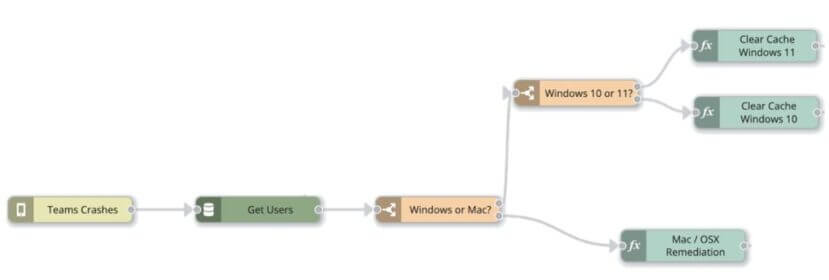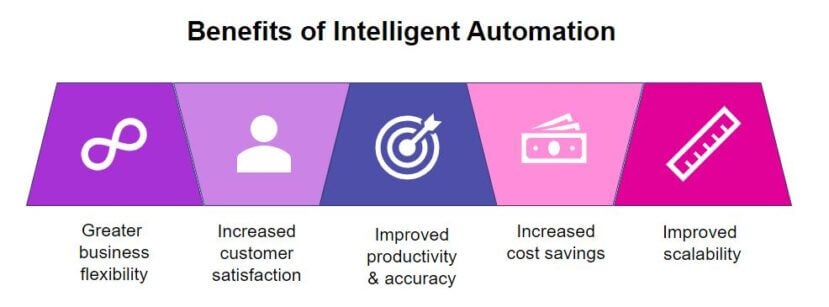Intelligent automation uses advanced technologies such as machine learning (ML), correlation, and automation to automate IT operations tasks. This involves the use of smart algorithms and runbook workflows to identify and automate routine, repetitive, and time-consuming tasks, freeing up IT staff to focus on more strategic and creative work.
Riverbed uses intelligent automation to automate a wide range of IT processes, including incident response, security forensics investigations, desktop remediation, and providing intelligence to trouble ticketing. Automation can help improve operational efficiency, reduce errors, and enhance the overall quality of IT services.
Intelligent IT automation also provides actionable insights to help IT teams identify and address potential problems before they occur. This can help organizations achieve greater agility and flexibility in their IT operations, while also reducing costs and improving the overall quality of service.
Why use Intelligent Automation?
The proliferation of new applications is generating an overwhelming volume of data, leading to alert overload. It is simply no longer possible for IT teams to analyze and correlate all this data manually and still meet operational expectations.
In addition, alert overload is compounded by today’s scarcity of skilled IT resources–fewer IT staff are left to do more of the work. And, these already short-staffed IT teams must often chase false positives, events that don’t impact digital experience. The lack of automation of these workflows results in longer resolution times of critical issues and higher error rates, both of which can negatively impact user experience and business performance.
How Riverbed IQ leverages Intelligent Automation
Riverbed IQ unified observability service automates incident response of performance and security events and provides intelligent trouble ticketing to ServiceNow.
Incident response
With the Riverbed portfolio’s full-fidelity insights and rich analytics, complex troubleshooting workflows become razor sharp, highly automated processes. Riverbed IQ replicates the advanced investigative processes of Network Operations teams, providing context-driven insights that empower them to proactively resolve issues without escalating.
Security forensics investigations
SecOps teams want easy access to all data sources and to integrate that data into their SOAR and SIEM tools. Riverbed IQ provides out-of-the-box runbooks for security investigations. These runbooks give SecOps teams easy access to Riverbed telemetry data to help fully investigate threats. As a result, security tools gain more context for threat investigations, reducing risk to the business.
Auto-populating trouble tickets
In today’s modern IT market, targeted delivery of fast, context-driven insights to ITSM solutions can mean the difference between business triage and business optimization. Riverbed IQ uniquely delivers deep ServiceNow incident context that streamlines ticket creation and reduces escalation. Riverbed IQ links back to the originating source telemetry to assemble supporting troubleshooting data. Data collected can include network, infrastructure, application, and end user experience.
Automation guides Aternity remediations
Aternity end user experience monitoring is also leveraging intelligent automation from the Riverbed Observability platform. Unlike other solutions that require a multitude of remediation scripts that address narrow use cases, Aternity sets itself apart by offering one-click remediation actions that can dynamically mimic expert decision-making by constructing logic-driven remediation workflows using reusable steps. This enables the resolution of both simple and complex issues. Combined with the fact that Aternity offers an extensive catalog of Macintosh and PC remediations for recurring desktop issues such as application hangs, boot and login times, network connectivity, application crashes, OS crashes and more, IT can have more time to focus on innovation.

What’s the difference between AI and Intelligent Automation?
AI or Artificial Intelligence is excellent at sorting and classifying both structured and unstructured data. It can provide deep insights into trends, patterns and outliers. For example, a well-trained AI algorithm can execute tasks like recognizing the contents of an image, understanding the contents of a document, correlating related events, and more.
Intelligent automation, on the other hand, refers to the use of advanced technologies such as AI, machine learning, correlation, and automation workflows to automate IT processes. Intelligent automation combines the power of automation with AI to create systems that make decisions with minimal human intervention.
AI is a necessary component of intelligent automation. The main difference between the two is that AI is focused on creating intelligence, while intelligent automation is focused on automating specific tasks or processes to increase efficiency and productivity.
Benefits of Intelligent Automation
McKinsey Global Institute estimates that knowledge work automation tools could take on tasks that would be equal to the output of 110 million to 140 million full-time equivalents (FTEs). They feel it’s possible this incremental productivity could have as much as $5.2 trillion to $6.7 trillion in economic impact annually by 2025.

Other benefits of IT automation, include:
- Increased efficiency: Automation can significantly improve efficiency by automating repetitive tasks, reducing manual effort, and speeding up processes.
- Improved accuracy: Automation can decrease the risk of human error, improving accuracy and reliability of IT processes.
- Better resource utilization: By automating routine tasks, IT staff can focus on more strategic and complex tasks, making better use of their skills and expertise.
- Faster MTTR: Automation reduces the time required to complete tasks, speeding the recovery of applications and services.
- Cost savings: Automation decreases the need for manual labor, saving costs on other operational expenses and allowing staff to work on more strategic projects.
- Scalability: Automation helps organizations scale their operations easily and cost-effectively, by limiting the need for manual analysis.
- Improved customer satisfaction: Automation delivers consistent and high-quality services, leading to increased customer satisfaction.
Overall, Intelligent Automation helps organizations improve their agility, reduce costs, and deliver better quality services to their customers. For more information on how you can use Riverbed’s Intelligent Automation capabilities to improve your IT environment, visit the new Intelligent Automation page.
